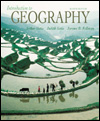Web Page Questions: Answer the following questions using the web pages listed in the question.
1. International Organization for Migration - http://www.iom.int/ a. How many member nations are there in the International Organization for
Migration? b. What is the mission of the IOM?
Problems: 1. Climatic, geologic and other conditions make certain places on the earth
more susceptible to specific natural hazards such as earthquakes, hurricanes,
tornadoes, severe cold/snow and floods. The identification of hazard
prone areas is an important task of geographers. a. The following map contains the locations of major metropolitan areas in
the United States. By referring to material in this and other chapters (particularly
Chapters 3 and 4), identify those regions that are constantly at risk of experiencing
each of the major natural hazards listed below. Use a shading or color scheme
to differentiate the hazard prone regions. b. For each of the major hazards, list those metropolitan areas that are
at risk with respect to them.
| Hazard | Metropolitan Areas | | Earthquakes | | | Hurricanes | | | Tornadoes | | | Severe cold/snow | | | Floods | |
c. If these regions and urban areas are in such danger from recurrent natural
hazards, why do large numbers of people continue to locate in them?
 <a onClick="window.open('/olcweb/cgi/pluginpop.cgi?it=jpg::Metropolitan Centers::/sites/dl/free/0072367229/9468/image08_01.jpg','popWin', 'width=402,height=528,resizable,scrollbars');" href="#"><img valign="absmiddle" height="16" width="16" border="0" src="/olcweb/styles/shared/linkicons/image.gif">Metropolitan Centers (1007.0K)</a>Metropolitan Centers <a onClick="window.open('/olcweb/cgi/pluginpop.cgi?it=jpg::Metropolitan Centers::/sites/dl/free/0072367229/9468/image08_01.jpg','popWin', 'width=402,height=528,resizable,scrollbars');" href="#"><img valign="absmiddle" height="16" width="16" border="0" src="/olcweb/styles/shared/linkicons/image.gif">Metropolitan Centers (1007.0K)</a>Metropolitan Centers 2. The mental maps we carry around in our heads play an important role in how
we interact with our daily environment. In the space provided draw from memory
the campus of your college or university. Do this without referring to a campus
map. Include as many of the buildings and other features as possible, such as
plazas, pathways, boundaries, streets, and open spaces. Once you have completed
your "mental map", compare it with an "official" campus
map and ask yourself the following questions: - How "accurate" is your map compared to the official one? __________________________________________________________________________________________
__________________________________________________________________________________________
- What features have you emphasized by making them larger than they actually
are? __________________________________________________________________________________________
__________________________________________________________________________________________
__________________________________________________________________________________________
- Why have you emphasized the features that you did, such as certain buildings,
pathways, boundaries and nodes? __________________________________________________________________________________________
__________________________________________________________________________________________
__________________________________________________________________________________________
- How accurately have you estimated the distances between locations on your
map, and why do they not conform to actual distances? __________________________________________________________________________________________
__________________________________________________________________________________________
__________________________________________________________________________________________
Critical Thinking Questions - Insurance rates for natural hazards are based on the likelihood of something
happening or not happening. Insurance companies are also engaged in studying
ways to prevent bad things from happening, and by extension, a claim from
being filed. These companies work with governmental officials and also conduct
their own education campaigns. What role would a geographer plan in an insurance
company think-tank?
- Mary and Frank regularly take a 2.5 hour drive to Atlantic City, NJ yet
have not visited well-liked relatives one hour away, citing the reason "Its
is too far to travel". How would you explain this spatial interaction
or lack thereof?
- Discuss the erroneous statement "The shape of a valley will not influence
people's use of it."
- Select six places with 3 different and 3 similar psychological appeals located
within the same time-distance relationship to your school but in different
directions. Ask a variety of people whether or not they would frequent each
place. Map their responses and analyze their answers.
- Assume you work for a real estate company. You need to find a site for a
family of five to buy or rent a house. Both parents have jobs (one full-time
and one part time) in different parts of the metropolitan area and the three
children, ranging in age from 10 to 18, have a variety of extra-curricula
activities and rely on mass transit. How would you conduct a spatial search
of the area within a 50-mile radius of the full-time wage earner's work site?
|



 2002 McGraw-Hill Higher Education
2002 McGraw-Hill Higher Education